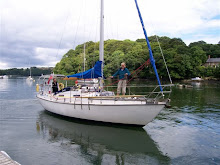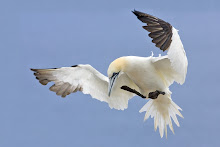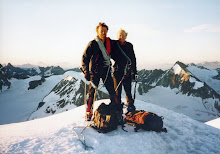We had no bad weather apart from a few squalls. During one of them, while sailing at full speed, the main sail slam jibed, (mischievously got out of control) (Mea-culpa) causing the main sheet block to fail. It was an exciting few minutes in the wee small hours before I was able to lower the main sail and continue with just the jib. No great harm was done and I was able to repair the block during daylight hours the next day.
On another occasion the main halyard chafed through. So up the mast I went and swapped it for the topping lift. It was rather bouncy, so I didn’t stay up there too long. The next day the weather was fine and the sea calm, so I was able to climb the mast again, and find out why it had chafed through. Interestingly, going aloft was much easier with the steadying influence of the main sail and spinnaker.
The view from aloft
The view from below
I think that two quite minor problems aren't bad in 3,000 miles of continuous sailing.
Guess Who
We spent a fortnight or so exploring these beautiful islands. They really are lovely, as are the people. While looking around the village of Viatahu on Tahuata island, we asked a man if it was permissible for us to walk along a small path by his house, that we thought would lead back to the beach. We were assured that it was, but were not allowed to leave before being presented with a bag of fruit from his garden. We were given mangos, funny little apples and two enormous grapefruit. What kindness and generosity!
A Reef at low tide
Our daily routine became rather monotonous. Keeping four hour watches day and night, eating, sleeping, reading our Kindles and listening to music on our Walkmans. We couldn’t complain though, mid ocean adventures were something we could well do without. We kept a log book of our progress and half way across the Pacific Ocean, it was interesting to note that in terms of distance, we were in one of the remotest places on Earth.
“Hello Pippa, what have you got planned for today?”
I thought I might go sailing.”
“Good idea, I think I will too.”
“Hello Pippa, what have you got planned for today?”
I thought I might go sailing.”
“Good idea, I think I will too.”
Jolly useful things, Spinnaker poles.
We saw no other yachts and only one ship during our crossing. Early one morning a container vessel came close while overtaking us, and inquired over the VHF Radio if all was well. On being assured that all was indeed well, he wished us the traditional "Good watch" before disappearing over the horizon. Ships that pass in the night! How nice of him to take an interest in our welfare.
I have come to accept that I am no fisherman.
We caught not a single fish during the whole passage, though two got away.
Our land fall in the Marquesas was Atuona, in Hiva Oa. We were most impressed by the lush vegetation and fine mountain scenery, unfortunately, hill walking was not an option, we had no map. We did get some exercise by walking along a scenic road for over a mile to the village of Atuona. This was enough considering the state of atrophy of our walking muscles.
The highlights were visiting the Gauguin museum and Gauguin’s house, for it is here he died and is buried. A little less cultural was the Miss Hiva Oa Final. We went along in a spirit of participation and found the traditional dress section and the traditional dance that accompanied this were superb.
Sula at Fatu Hiva
Exploring Fatu Hiva
We spent a fortnight or so exploring these beautiful islands. They really are lovely, as are the people. While looking around the village of Viatahu on Tahuata island, we asked a man if it was permissible for us to walk along a small path by his house, that we thought would lead back to the beach. We were assured that it was, but were not allowed to leave before being presented with a bag of fruit from his garden. We were given mangos, funny little apples and two enormous grapefruit. What kindness and generosity!
Traditional Polynesian canoe
On another occasion three young men arrived at our quiet anchorage in traditional Polynesian outrigger canoes. (Real wooden ones) We had been ashore on Oa pou exploring and met them as they landed on the coral shore. They presented Pippa with a large papaya (Their only one) and carried our inflatable to the water’s edge for us. They made nothing of the gesture. It’s just the way these warm hearted people behave.
Tiki found on Nuka Hiva
Many of the Tikis were destroyed by misguided missionaries.
(But how did the ancients get hold of Carbon Fibre?)
On another occasion three young men arrived at our quiet anchorage in traditional Polynesian outrigger canoes. (Real wooden ones) We had been ashore on Oa pou exploring and met them as they landed on the coral shore. They presented Pippa with a large papaya (Their only one) and carried our inflatable to the water’s edge for us. They made nothing of the gesture. It’s just the way these warm hearted people behave.
Our Papaya. A gift from Oa Pou
Nuku Hiva is the capital of the Marquesas. Here again we joined in the celebrations leading up to Bastille Day. One evening we were treated to a most spectacular Fire Dance. Men and women in traditional costume were engaged in a varied series of dances while carrying flaming torches. They were accompanied by a band of drummers, with a range of drums, the biggest reaching up to their shoulders, and they were big men. The whole spectacle seemed to get right inside us. The raw power of the drums and chants of the dancers made our chests seem to resonate to the music.
Tiki found on Nuka Hiva
The following day we got up early and paddled ashore for some early morning shopping.
After completing our mission we were treated to a splendid display of men, women and young boys riding bare back ponies, first a formal procession past the Mayor and other dignitaries (but very few tourists) then gallops along the beach. Horses and riders were in traditional dress, many of the men bare chested, displaying wonderful tattoos. It was the best shopping trip I have ever had!
As I write we are in Rangiroa, the capital of the Tuamotu Archipelago. The islands are a scattering of small atolls whose highest point is often the coconut palms on the beach. Once again we had a quiet passage, though this time it was only 500 miles.
High ground in the Tuamotus
Until the advent of GPS, these islands were feared by sailors and known as the Dangerous Islands. They are so low lying they can’t be seen until one is almost on top of them. In addition, strong currents flow between the atolls. Entrance to the lagoon is through a narrow pass in the coral reef. Then, as if all this wasn’t enough, their final defence is often strong currents (up to nine knots) in the passes themselves. You will have guessed by now that these currents are difficult to predict. Waves, built up by the trade winds, crash into the coral reef on the windward side of the islands and spill over into the lagoon. The result is that the outgoing streams often run for ten hours out of twelve hours of tide.
The trick is to only visit an island if you have an up to date chart. Watch your GPS like a hawk, approach cautiously with the engine running and if you don’t like the view ahead, remember that discretion is the better part of valor and beat a hasty retreat.
Of course, local knowledge can be a bonus, but not always. On Kauehi we had an exciting entrance:-
As we approached everything looked fine until we were committed to running the pass. Then quite big waves suddenly appeared ahead. Our only recourse was to put the engine to full ahead in order to remain in control as we surfed down the waves. Thankfully it didn’t last long and we were soon spat out into the calm of the lagoon. Not wishing to repeat the experience we asked ashore about the best time to leave the following morning. No one seemed to know! (Even an old man who looked as though he had once been a fisherman) We never did find an answer to our question. Our favorite quote was from a very pleasant young man from another island, visiting his sister. “I haven’t a clue, I come and go by aeroplane”!
So; though a trifle apprehensive, we left at first light the following morning. Luck was with us, we caught the pass in benign mood and it allowed us through with the merest ripple in evidence to remind us of its power.
It hasn’t all been an adrenalin trip in the Tuamotus. We visited four islands in the archipelago. Kauehi, Fakarava, Toau and Rangiroa. We have found lovely quiet sheltered anchorages with good snorkeling. The natives are friendly if understandably retiring and the sun shines most of the time.
We stayed in Rangiroa for a few more days, to publish this Blog update and prepare for the 200 mile passage to Tahiti. Well; The best laid schemes of mice and men. Our internet connection let us down. So we sailed without publishing the latest installment of the Blog.
A coconut crab at the entrance to its burrow.
It’s a shame but despite their name they rarely eat coconuts.
We are now in Tahiti. The passage went without any problems, though it was a trifle more boisterous than we might have wished. We were on a broad reach or occasionally a reach all the way across, with force 4 or 5 winds and a trade wind swell. Quite breezy! We sailed at six knots or more, most of the way and to be honest it was a mite uncomfortable. Spray flew everywhere. Ho hum. If one will go sailing! To add insult to injury we arrived off Tahiti in the late evening. I lacked the courage to brave the pass through the reef, in strong winds and darkness. So we spent the night hove too. (As near to stopped as one can be at sea). In the early morning of Sunday, we anchored in a delightful and sheltered lagoon in Tahiti. To both our surprise and delight we had the anchorage to ourselves. We slept well that night.
We have looked at alternative anchorages and there are several available, but so far none can better the one we are in. So here we shall stay. One of it’s many delights is that each evening and often early in the morning the local canoe club turn up in force to practice. The craft are always carbon fiber versions of the traditional Polynesian canoe. They are mostly single seat craft but sometimes two or three seat versions. We have even seen two twelve seat monsters. The link between all of them is that they are propelled with the latest design of cranked paddles and that they go like stink.
Polynesian canoes in Tahiti.
We are now looking forward to exploring the Society Islands for the rest of August. They are reported to be “intriguing to visit, with beautiful lagoons, good walking and friendly people” I will let you know.















